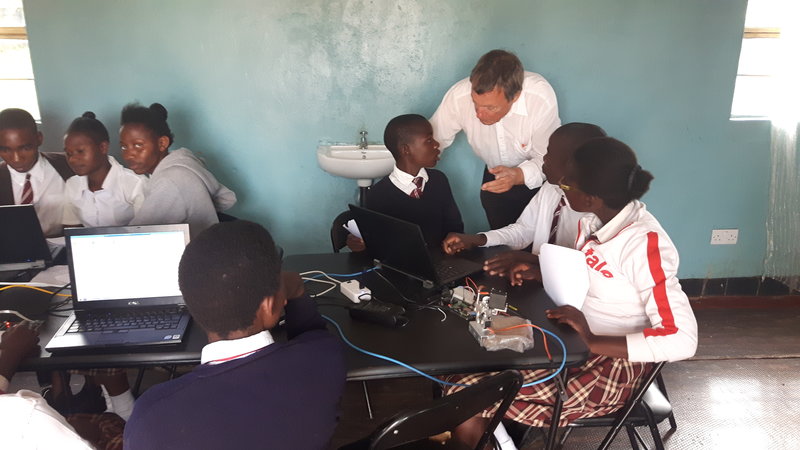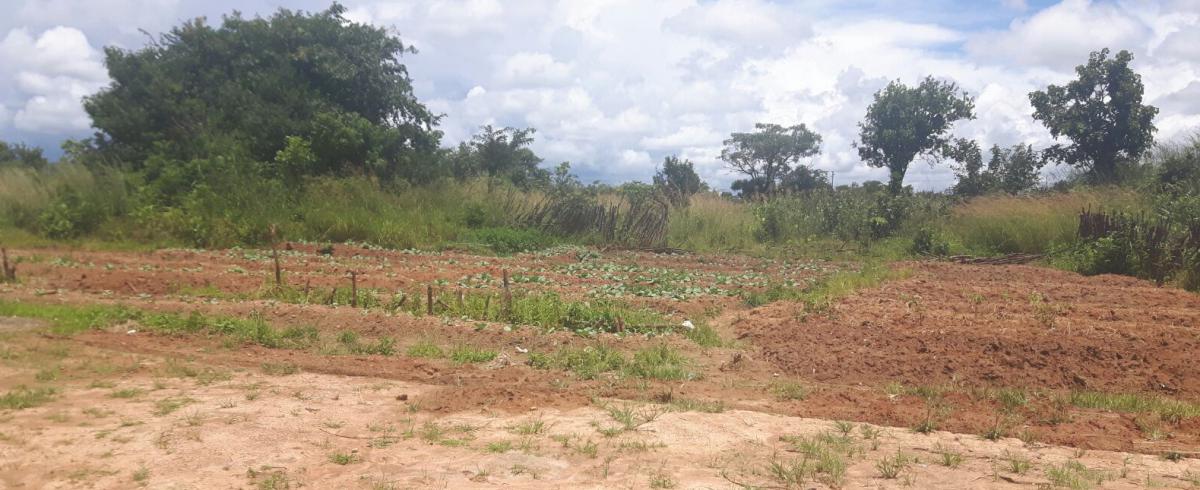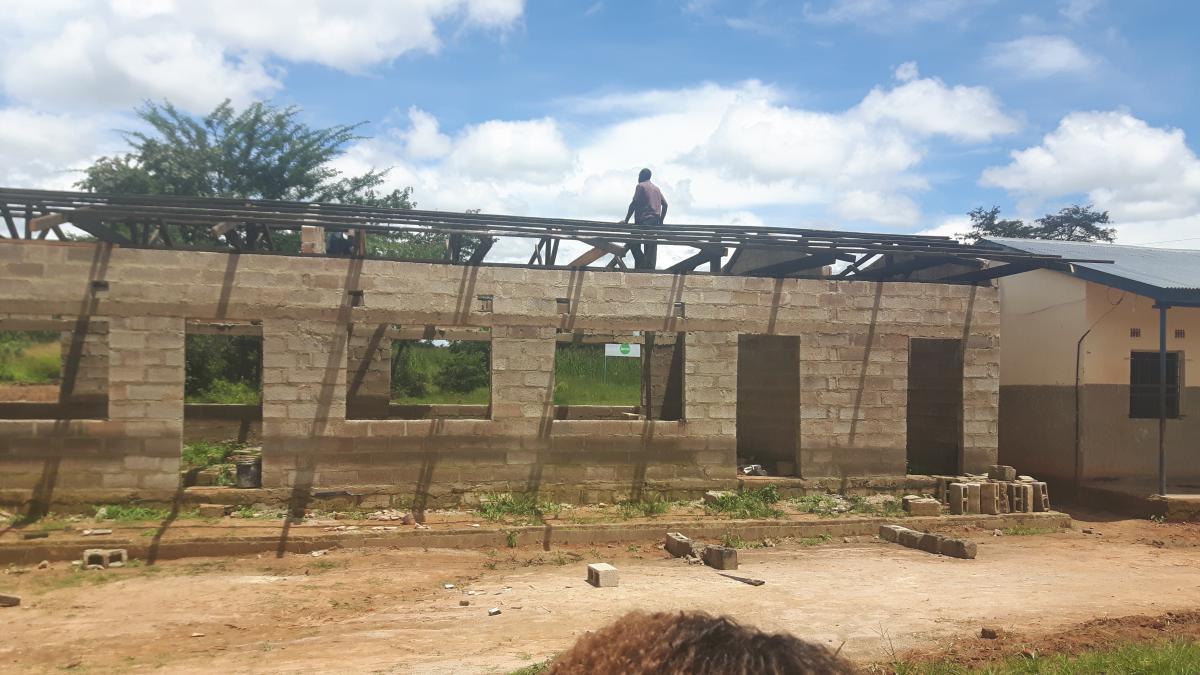Two years ago the CiTA — Computers in Technical Applications — project started. The aim of this project is to let the students gain knowledge in controlling equipment using computers. In that way they become familiar with a variety of sensors and actuators — and the underlying physical principles — as well as with the development of software for the communication of the computer with the ' surrounding world '. Writing software trains the student in analyzing technical problems and stimulates logical thinking.
Within the courses that have been developed for the project, we use the Raspberry Pi microcomputer and a variety of electronic components ranging from LED's and sensors to a camera and a small programmable robot arm. The programming language used is Python — a very accessible programming language for students at the high school level. For interested people, a pdf version of the workshop handout is available under ' Documents ' on this website. For non-commercial use, the document is available free of charge. Please include acknowledgment when it is distributed.
Like previous years several workshops have been given at Kalwala Secondary School. Especially the programming of the robot arm was a success. The students have enjoyed attending the workshop and worked with a commitment on the different assignments.
Our ideal is that a course in this area will be offered as an (optional) subject at secondary schools in the future. This is also what happens elsewhere — particularly in Anglo-Saxon countries. For the time being, the course is embedded in the JETS-club (Junior Engineers, Technicians and Scientists). The equipment has been donated to the club so that the students can work on new projects with the assistance of the school teachers.
The workshop was previously given at the University. Our intention was to do this again for the department where ICT teachers are trained. Unfortunately, this had to be postponed since the University was temporarily closed because of the cholera outbreak elsewhere in the country.
The picture below shows the dining hall and the students getting their daily lunch. In addition to the use of the hall for lunches and evening meals (for the students that do not go home at night) the hall is important for social activities, exams, and other events where the whole school is involved.
In the beginning, only maize was grown in the school garden. Maize is the staple food in Zambia and is eaten both in the afternoon and in the evening. Since vegetables are an important part of the daily meal also cabbage has been planted now in the school garden. Other vegetables such as tomatoes, onions and different types of green leaves will follow.
The number of students at Kalwala Secondary School is increasing. That applies to both the academic and the vocational sections. Altogether there are now about 350 students. Considering the number of pupils at the feeding primary schools an increase is foreseen for the next planning period of up to 400 a 450 students. Therefore extra classrooms are being built now. The construction is being paid from contributions of the parents - no small task because after building the classrooms there come other expenses like furniture and teaching material. But education is considered important and therefore all contribute as they can. Our Foundation also hopes to contribute to the necessary growth of the school in the coming years.
Two years ago the CiTA — Computers in Technical Applications — project started. The aim of this project is to let the students gain knowledge in controlling equipment using computers. In that way they become familiar with a variety of sensors and actuators — and the underlying physical principles — as well as with the development of software for the communication of the computer with the ' surrounding world '. Writing software trains the student in analyzing technical problems and stimulates logical thinking.
Within the courses that have been developed for the project, we use the Raspberry Pi microcomputer and a variety of electronic components ranging from LED's and sensors to a camera and a small programmable robot arm. The programming language used is Python — a very accessible programming language for students at the high school level. For interested people, a pdf version of the workshop handout is available under ' Documents ' on this website. For non-commercial use, the document is available free of charge. Please include acknowledgment when it is distributed.
Like previous years several workshops have been given at Kalwala Secondary School. Especially the programming of the robot arm was a success. The students have enjoyed attending the workshop and worked with a commitment on the different assignments.
Our ideal is that a course in this area will be offered as an (optional) subject at secondary schools in the future. This is also what happens elsewhere — particularly in Anglo-Saxon countries. For the time being, the course is embedded in the JETS-club (Junior Engineers, Technicians and Scientists). The equipment has been donated to the club so that the students can work on new projects with the assistance of the school teachers.
The workshop was previously given at the University. Our intention was to do this again for the department where ICT teachers are trained. Unfortunately, this had to be postponed since the University was temporarily closed because of the cholera outbreak elsewhere in the country.
The picture below shows the dining hall and the students getting their daily lunch. In addition to the use of the hall for lunches and evening meals (for the students that do not go home at night) the hall is important for social activities, exams, and other events where the whole school is involved.
In the beginning, only maize was grown in the school garden. Maize is the staple food in Zambia and is eaten both in the afternoon and in the evening. Since vegetables are an important part of the daily meal also cabbage has been planted now in the school garden. Other vegetables such as tomatoes, onions and different types of green leaves will follow.
The number of students at Kalwala Secondary School is increasing. That applies to both the academic and the vocational sections. Altogether there are now about 350 students. Considering the number of pupils at the feeding primary schools an increase is foreseen for the next planning period of up to 400 a 450 students. Therefore extra classrooms are being built now. The construction is being paid from contributions of the parents - no small task because after building the classrooms there come other expenses like furniture and teaching material. But education is considered important and therefore all contribute as they can. Our Foundation also hopes to contribute to the necessary growth of the school in the coming years.




